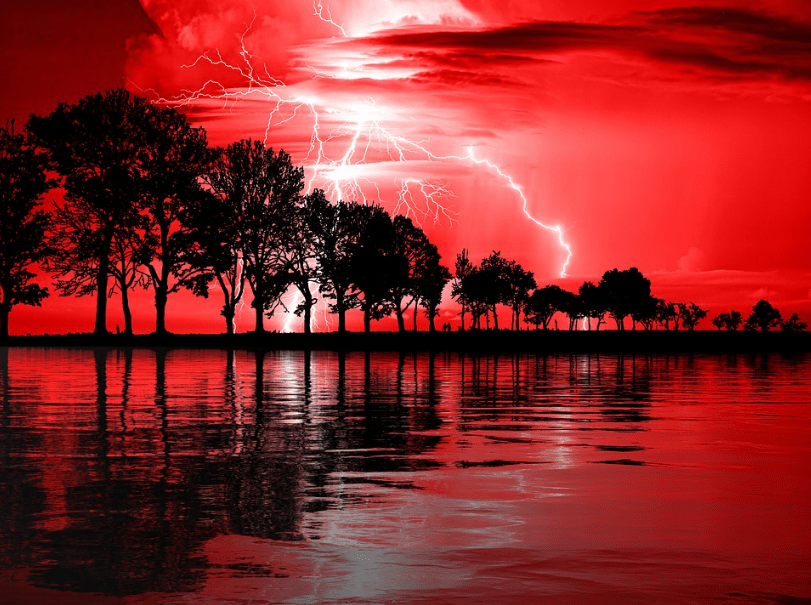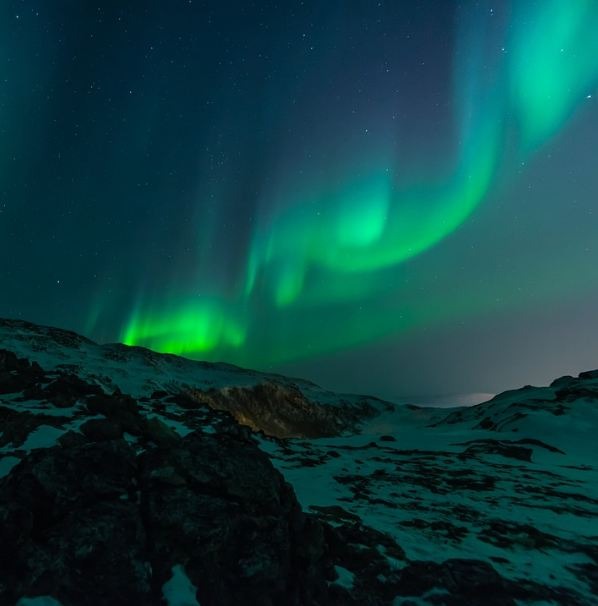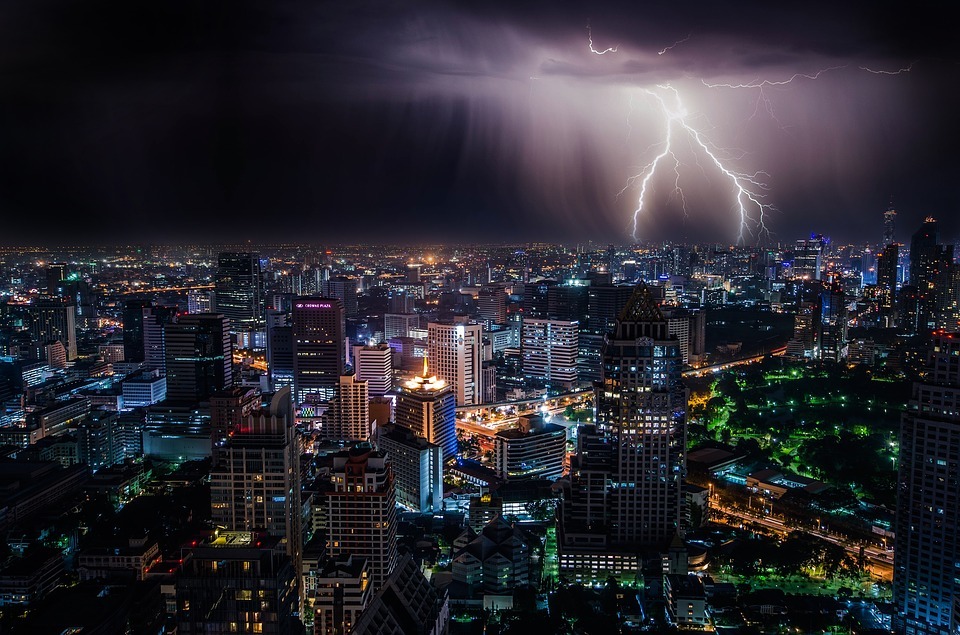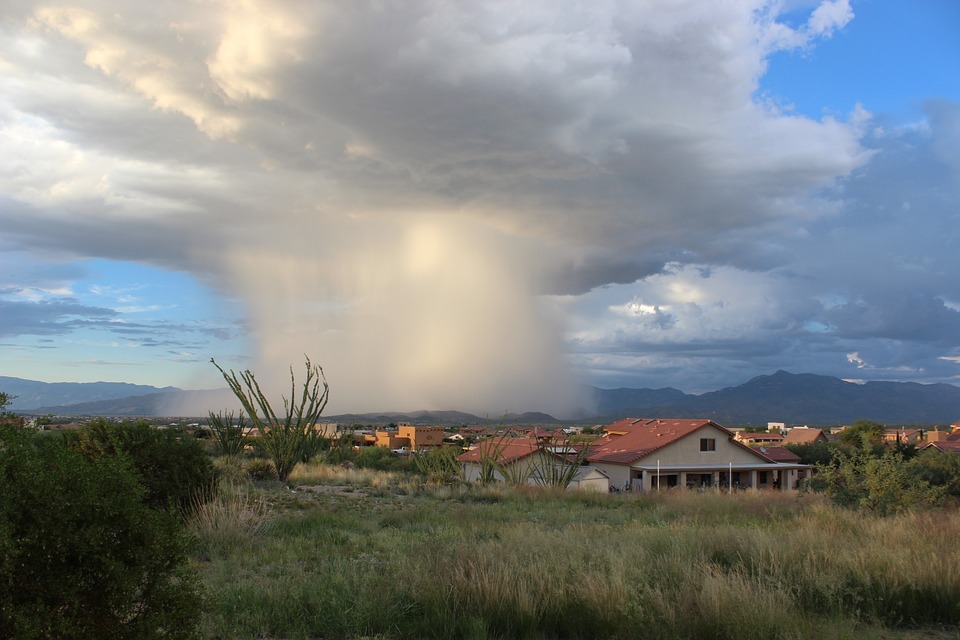What Causes the Northern Lights?
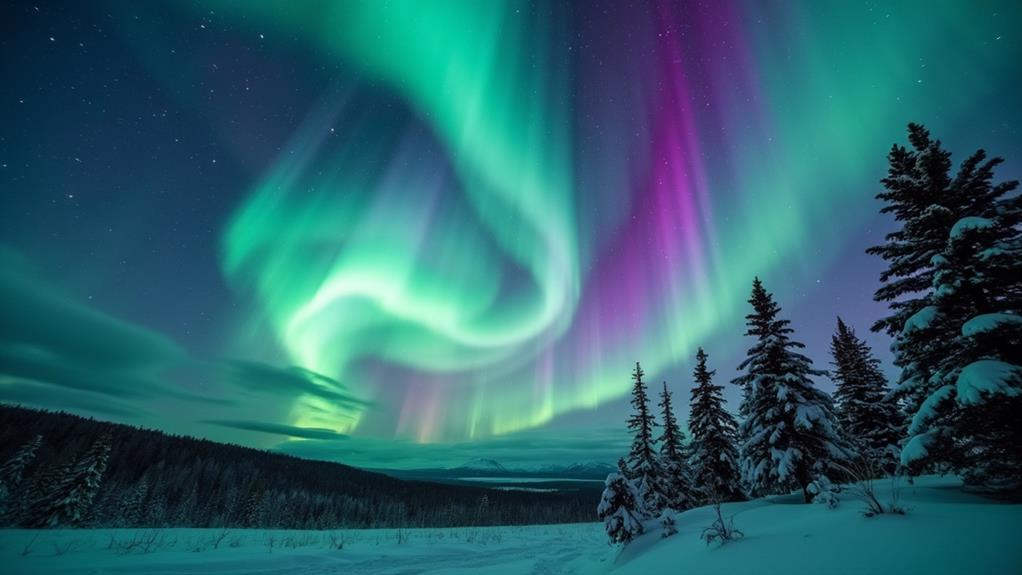
When you think about the Northern Lights, you probably picture those mesmerizing displays of vibrant colors dancing across the polar skies. But have you ever wondered what creates this natural spectacle? It begins with solar activity, where charged particles from the sun travel through space and collide with Earth's atmosphere. These interactions with gases like oxygen and nitrogen produce the vivid lights you see. The colors result from the specific types of gases involved and the altitude at which these collisions occur. Earth's magnetic field plays a crucial role in directing these particles towards the polar regions, creating the stunning displays. Let's explore these phenomena in detail.
Formation of Northern Lights
When you witness the stunning display of the Northern Lights, known as the aurora borealis, you're observing a complex interaction between the Sun and Earth's atmosphere. This phenomenon begins with the Sun releasing charged particles during solar flares and coronal mass ejections. These particles are carried by the solar wind, traveling approximately 93 million miles to reach Earth in about 3-4 days.
Upon reaching Earth, these charged particles are directed by Earth's magnetic field towards the polar regions. In these high-latitude areas, the particles collide with atmospheric gases, primarily oxygen and nitrogen. These collisions excite the atoms in the gases, causing them to release energy in the form of light, creating the mesmerizing colors of the aurora borealis.
The specific colors of the aurora depend on the type of gas and the altitude of the collisions. Oxygen at lower altitudes typically produces green light, the most common color, while oxygen at higher altitudes can result in red hues. Nitrogen, on the other hand, can produce blue or purplish-red colors.
Role of Solar Activity
Understanding the formation of the Northern Lights is essential to exploring the role of solar activity in this awe-inspiring phenomenon. Solar activity, particularly through events like Coronal Mass Ejections (CMEs), releases streams of charged particles known as solar wind. These particles travel approximately 93 million miles from the Sun to Earth. Typically, auroras appear 3-4 nights after significant solar activity, as the solar wind reaches our planet.
The solar wind's interaction with Earth's magnetic field is crucial. When these charged particles collide with the magnetic field, they are directed towards the polar regions, leading to the spectacular light displays known as auroras. During periods of high solar activity, such as solar maximums, which follow an 11-year cycle, you can expect more frequent and intense auroral displays. The current cycle is predicted to peak between early 2024 and late 2025.
Enhanced solar storms during these peak periods can even make auroras visible farther south than usual, expanding their geographical range. Therefore, if you're planning to witness this natural wonder, monitoring solar activity forecasts will give you the best chance to see the Northern Lights in their full splendor.
Interaction With Earth's Atmosphere
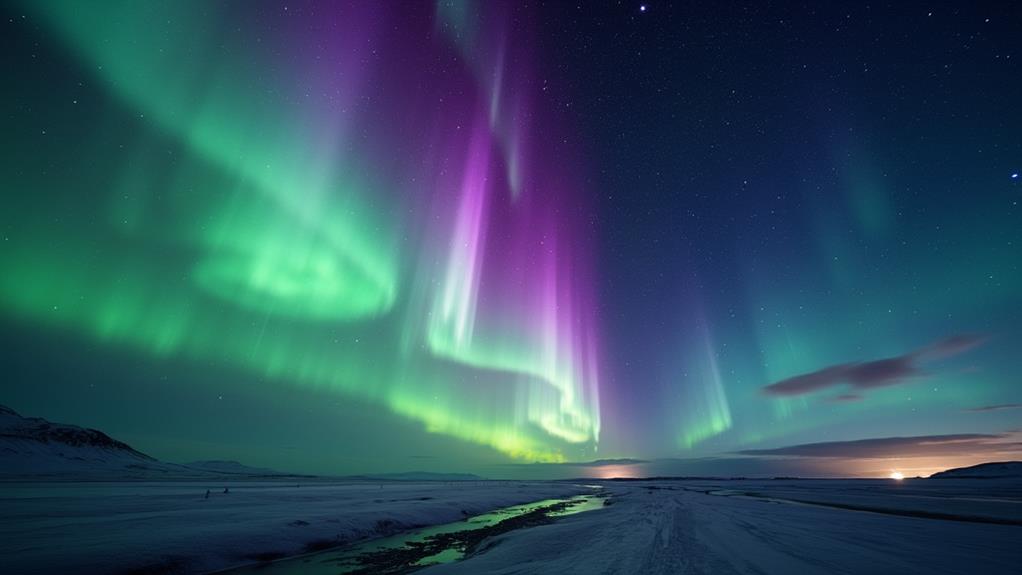
When charged particles from the solar wind encounter Earth's magnetic field, they are funneled towards the poles, where they collide with atmospheric gases such as oxygen and nitrogen. These collisions energize the gases, causing them to emit light and create the vibrant colors of the auroras. By understanding this process, it becomes clear how the northern lights are a stunning result of complex interactions within our atmosphere.
Charged Solar Particles
Ever wondered how the spectacular northern lights come to life? It all begins with charged particles from the solar wind. These particles, propelled by the sun, travel through space and eventually collide with Earth's atmosphere. When solar storms occur, the number of these charged particles increases dramatically, enhancing the intensity of the aurora borealis.
As the charged particles from the solar wind enter Earth's atmosphere, they encounter oxygen and nitrogen atoms. This collision excites the atmospheric gases, causing them to release photons, which are particles of light. The result is the breathtaking display of colors known as the northern lights. The most common aurora color is green, produced by oxygen molecules at altitudes between 100 and 300 kilometers. At higher altitudes, the same gas can create red auroras.
The extent and vividness of these lights can vary greatly depending on solar activity. During periods of heightened solar activity, such as solar storms or coronal mass ejections (CMEs), more charged particles reach Earth, resulting in more spectacular displays. So, the next time you see the aurora borealis, you'll recognize it's a direct result of those charged particles interacting with our atmosphere.
Magnetic Field Interaction
The Earth's magnetic field is crucial in the formation of the northern lights. When solar particles, driven by the solar wind, encounter Earth's magnetic field, they are directed toward the polar regions. This magnetic field acts as a shield, funneling these charged particles toward the poles where the field is strongest, creating an area known as the auroral oval.
As these charged particles penetrate the atmosphere near the magnetic poles, they collide with atmospheric gases. These collisions excite the atoms in the gases, causing them to emit light and produce the stunning auroras you see. The Earth's magnetic field essentially guides the solar particles to the right location for this light display to occur.
The colors in the auroras are influenced by the type of atmospheric gas involved in these collisions. Oxygen can emit green and red hues, while nitrogen often results in blue and purple shades. The density of the atmosphere at different altitudes also affects the colors and intensity of the auroras. This magnetic field interaction is essential for creating the breathtaking light displays known as the northern lights.
Atmospheric Gas Collisions
During the mesmerizing display of the northern lights, charged particles from the solar wind collide with oxygen and nitrogen atoms in Earth's upper atmosphere, producing bursts of light. These collisions are vital for creating the auroras' vibrant colors. When charged particles collide with oxygen atoms at lower altitudes, around 60 miles high, they emit green light. At higher altitudes, about 150 miles, these oxygen atoms can emit red hues.
Nitrogen molecules also contribute significantly to this light show. When excited by solar particles, they emit blue and purple shades, enhancing the aurora's color spectrum. The observed colors depend on the type of gas involved and the energy of the colliding particles.
These atmospheric collisions primarily occur near the magnetic poles, where Earth's magnetic field guides solar particles toward the atmosphere. The interaction between the solar wind and atmospheric gases results in the captivating northern lights, an extraordinary natural light display. Next time you see the auroras, you'll know they are the result of charged particles and atmospheric collisions producing this remarkable phenomenon.
Colors and Variations
The colors and variations of the northern lights offer a breathtaking display, primarily produced by the interaction of solar particles with different gases in Earth's atmosphere. When these solar particles collide with atmospheric gases, they create different hues in the auroras. For instance, oxygen molecules at around 100 kilometers (62 miles) produce the commonly seen green lights. At higher altitudes, above 300 kilometers (186 miles), oxygen interactions can also result in stunning red displays.
The array of colors you see in auroras depends on the type of gas involved and the altitude of the interactions:
- Green: Most common, produced by oxygen at 100 km.
- Red: Seen at higher altitudes, over 300 km, also due to oxygen.
- Purple and Blue: Generated by nitrogen at lower altitudes.
- Pink: Another result of nitrogen interactions.
- Scarlet Red: Often appears during energetic solar conditions at high altitudes.
The intensity of these colors can vary based on solar activity levels. During strong solar storms, you'll notice more lively and diverse colors in the auroras. So, next time you witness this natural marvel, you'll understand the science behind the mesmerizing display.
Viewing Locations and Tips
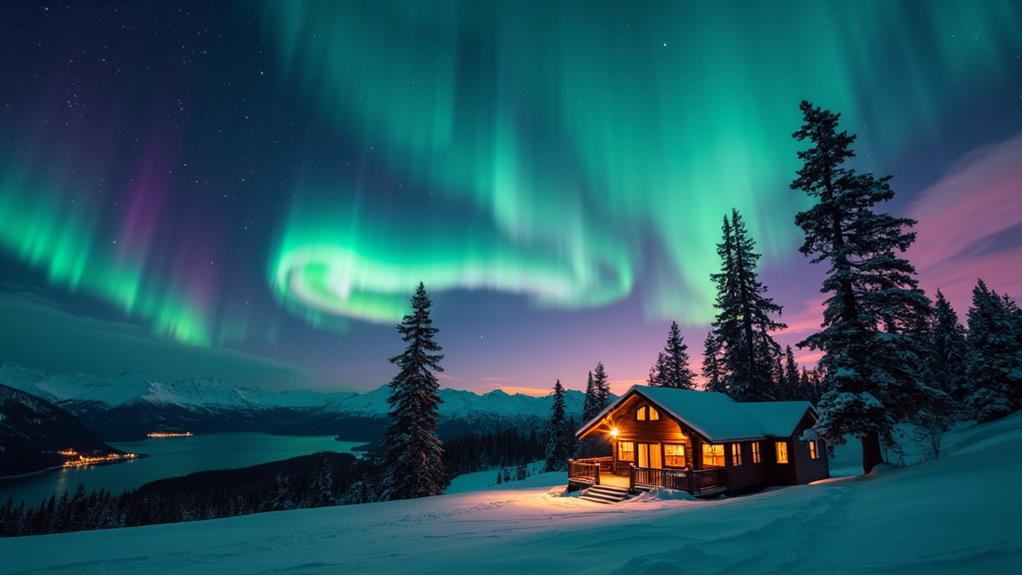
For those eager to witness the Northern Lights, selecting the right location is crucial. The optimal viewing spots are within the auroral zone, with prime locations including Fairbanks (Alaska), Yellowknife (Canada), Tromsø (Norway), Abisko National Park (Sweden), Rovaniemi (Finland), and various sites in Iceland. These areas offer the best opportunities to observe strong geomagnetic activity illuminating the sky.
Timing is equally important. The prime period to view auroras is from September to April, with peak activity occurring between 9 p.m. and 3 a.m. during the equinoxes. To maximize your chances, find dark locations away from city lights to minimize light pollution, which can significantly obstruct your view.
Weather conditions are also critical. Clear, cloudless skies are essential, so always check the local weather forecast before venturing out. Additionally, remember to dress warmly, as you will likely spend extended periods outdoors in freezing temperatures.
Here's a quick overview:
| Location | Best Time to Visit | Tips |
|---|---|---|
| Fairbanks, Alaska | September to April | Find dark spots away from city lights |
| Yellowknife, Canada | September to April | Seek clear, cloudless nights |
| Tromsø, Norway | September to April | Dress warmly for cold weather |
| Abisko National Park, Sweden | September to April | Check local weather forecasts |
| Rovaniemi, Finland | September to April | Avoid light pollution |
| Iceland | September to April | Monitor weather and dress appropriately |
Photography Techniques
To effectively capture the Northern Lights, set your camera to manual mode. Use a wide aperture, such as f/2.8, to maximize light intake. Stabilize your camera with a tripod and set your ISO between 800 and 3200 to balance sensitivity and noise reduction. Focus your lens to infinity and experiment with long exposures. Including interesting foreground elements can enhance your photographs.
Essential Camera Settings
Capturing the mesmerizing Northern Lights requires mastering key camera settings to ensure your photos do justice to this natural phenomenon. Aurora photography demands specific adjustments to your camera settings to effectively capture the vibrant colors and movements of the aurora borealis.
First, set your aperture to a wide setting, such as f/2.8 or f/4, to maximize light intake. This is crucial for capturing the often faint light of the Northern Lights. Next, adjust the shutter speed based on the aurora's activity. For fast-moving displays, use a shutter speed of 5-10 seconds, while slower movements may require 15-30 seconds.
Here are some essential camera settings to keep in mind:
- Aperture: Use f/2.8 or f/4 to gather more light.
- Shutter Speed: Adjust between 5-30 seconds depending on aurora movement.
- ISO: Set between 800-3200 to balance noise and light sensitivity.
- Focus: Set your camera to manual focus and adjust to infinity for sharp images.
- Stability: Use a sturdy tripod and a remote trigger or timer to avoid camera shake.
Optimal Shooting Conditions
Capture the magic of the Northern Lights by understanding the optimal shooting conditions that will help you photograph their full splendor. Begin by setting your camera to manual mode and using a large aperture, such as f/2.8, to maximize light intake in low-light conditions. This is crucial because the particles from the sun that interact with Earth's magnetic field to create the Northern Lights are most visible when you can gather as much light as possible.
For fast-moving auroras, use a shutter speed of 5-10 seconds. If the display is slower, extend the exposure time to 15-30 seconds. This flexibility allows you to adapt to varying solar activity and effectively capture the movement and colors.
Adjust your ISO settings between 800 and 3200 based on your camera's capabilities. Higher ISO settings can ensure vibrant color reproduction but be cautious of introducing excessive noise. A sturdy tripod is essential to stabilize your camera, as even minor movements can blur your long exposure shots.
Focus your camera to infinity for sharp images and consider using remote triggers or timer settings to minimize camera shake during exposure. By following these tips, you'll be well-prepared to photograph these mesmerizing celestial displays at their best.
Auroras on Other Planets
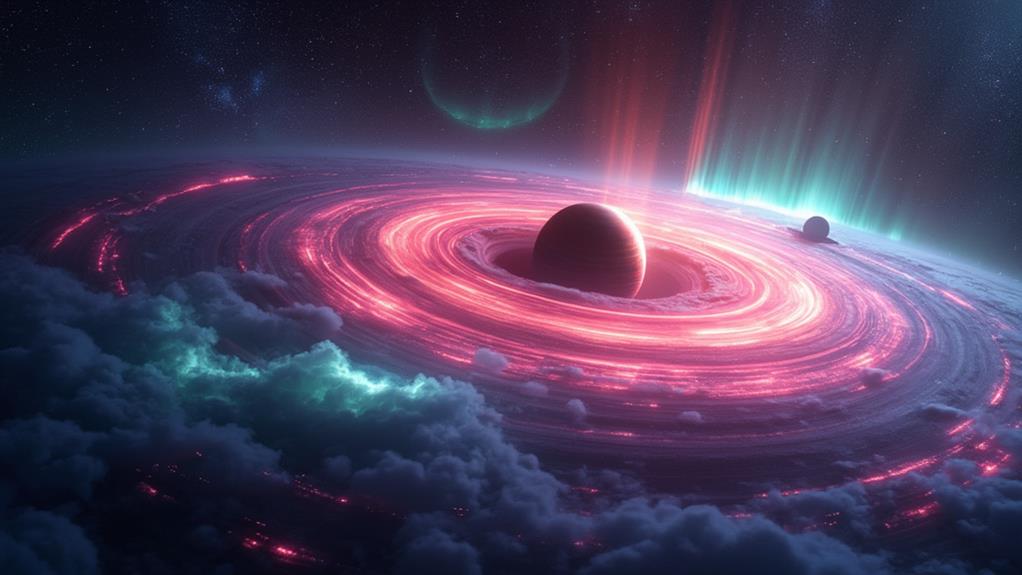
Auroras aren't exclusive to Earth; they've been observed on several planets in our solar system, showcasing the interplay between atmospheres and magnetic fields. For instance, Jupiter displays some of the brightest auroras, driven by charged particles from its moon Io, releasing more energy than all of Earth's auroras combined. Saturn also has remarkable auroras, typically seen in ultraviolet light, with intensity varying according to the solar cycle.
On Mars, despite lacking a global magnetic field, auroras can still be observed in three forms: dayside, widespread nighttime, and patchy nighttime, each behaving uniquely due to Mars' distinct atmospheric conditions. Observing auroras on other planets, such as Uranus and Neptune, enhances our understanding of their magnetic fields and interactions with the solar wind.
- Jupiter: Brightest auroras, influenced by moon Io's charged particles.
- Saturn: Ultraviolet auroras, intensity varies with the solar cycle.
- Mars: Three aurora types, influenced by localized magnetic fields.
- Uranus: Auroras help study its tilted magnetic field.
- Neptune: Auroras provide insights into its distant magnetic environment.

